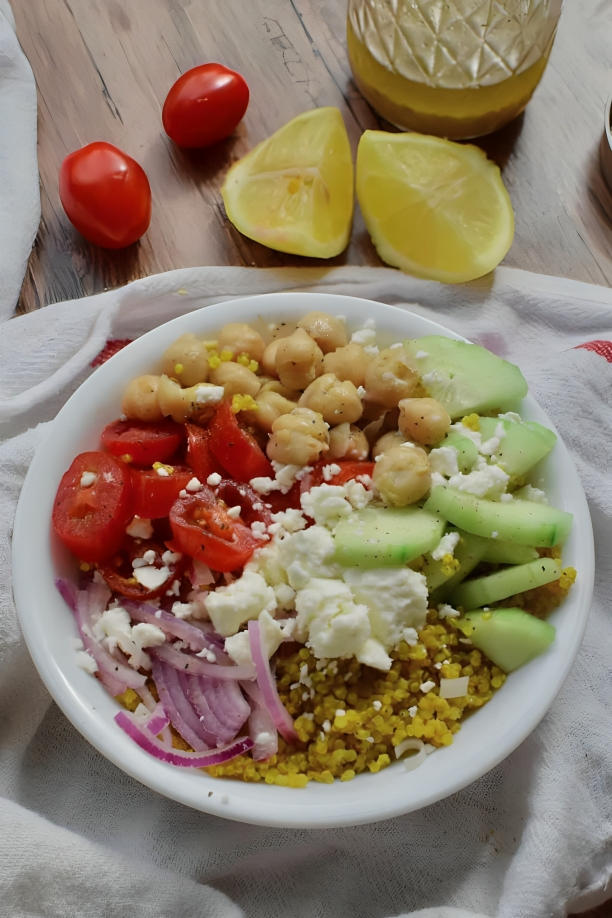Chickpea and Quinoa Salad Bowl Recipe (Mediterranean)
The Mediterranean Chickpea and Quinoa Salad Bowl is a healthy and delicious dish that combines the nutritional benefits of quinoa and chickpeas with the vibrant flavors of Mediterranean ingredients. It's a versatile recipe that allows for customization based on personal preferences and ingredient availability. With its balance of protein, fiber, and fresh vegetables, this salad bowl offers a satisfying and nourishing meal option suitable for various dietary preferences, including vegetarian and vegan diets. It's perfect for a light lunch, a side dish, or even a main course, providing a burst of Mediterranean-inspired flavors with every bite.
PREP TIME: 15MINUTES MINUTES
COOK TIME: 25MINUTES MINUTES
CALORIES: 474KCAL
COOK TIME: 25MINUTES MINUTES
CALORIES: 474KCAL
INGREDIENTS
Lemon Dressing:- 1/4 cup freshly squeezed lemon juice
- 1 teaspoon honey
- 1 teaspoon dried dill
- 1/4 teaspoon garlic powder (or 2 cloves garlic, minced)
- 1 teaspoon salt
- 1/2 teaspoon black pepper
- 1/2 teaspoon Dijon mustard
- 1/2 cup extra virgin olive oil
- 1 cup quinoa, rinsed
- 1/4 teaspoon garlic powder
- 1 1/2 teaspoons ground turmeric
- 2 cups water
- 1 1/2 cups cooked chickpeas (or 1 15 oz can), drained and rinsed
- 2 ripe tomatoes (or 1 pint cherry tomatoes), diced
- 1 cucumber, diced
- 1/2 red onion, finely chopped
- 1/4 cup crumbled feta cheese (optional
INSTRUCTIONS
- Begin crafting the marinade by combining lemon juice, honey, dried dill, garlic powder, salt, black pepper, and Dijon mustard in a mason jar.
- Seal the jar with its lid and give it a good shake to ensure all ingredients are well mixed.
- Transfer the cooked chickpeas to a small bowl and pour half of the prepared marinade over them, ensuring they are thoroughly coated. Set aside the remaining marinade for later use as the salad dressing.
TURMERIC QUINOA
- Rinse the uncooked quinoa under cold water and drain it well. Place the rinsed quinoa in a medium-sized saucepan with a lid.
- Add minced garlic, turmeric, and water to the quinoa in the saucepan, stirring to combine.
- Bring the mixture to a gentle boil over medium-high heat, then reduce the heat to medium-low, cover the saucepan with the lid, and let it simmer for approximately 12 minutes, or until the liquid is absorbed.
- Once cooked, remove the saucepan from the heat but leave it covered for an additional 5 minutes to allow the quinoa to steam and finish cooking. Set aside until ready to assemble the salad.
SALAD
- Thinly slice the onions and chop them into small pieces. Dice the tomatoes and cucumber into bite-size pieces.
- To assemble the salad, start by arranging a portion of turmeric quinoa on individual plates or in bowls.
- Top the quinoa with the marinated chickpeas, followed by the chopped onions, tomatoes, and cucumber.
- Sprinkle crumbled feta cheese over the salad and season with salt and pepper to taste.
- Finally, drizzle the reserved marinade/dressing over the assembled salad. Serve immediately and enjoy this vibrant and nutritious Mediterranean-inspired dish!
Nutrition
| Nutrition | Amount |
|---|---|
| Calories | 474 kcal |
| Carbohydrates | 42.4 g |
| Protein | 12.8 g |
| Fat | 29.7 g |
| Saturated Fat | 7.9 g |
| Cholesterol | 27 mg |
| Sodium | 962 mg |
| Potassium | 602 mg |
| Fiber | 6.3 g |
| Sugar | 5.5 g |
| Calcium | 210 mg |
| Iron | 4 mg |



